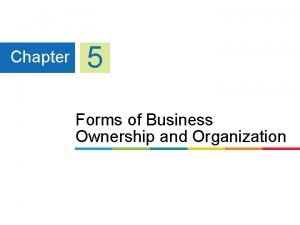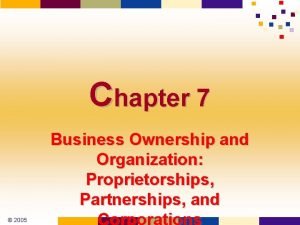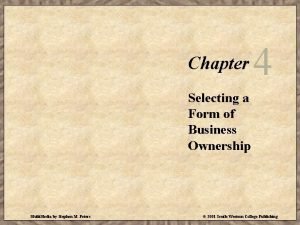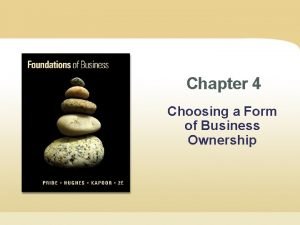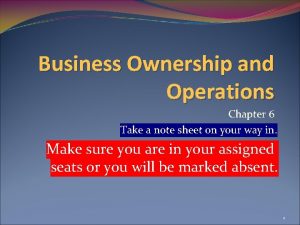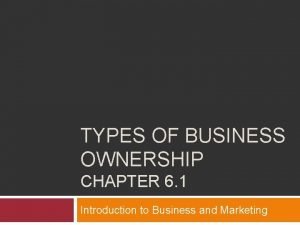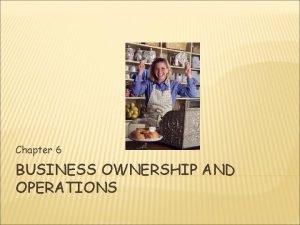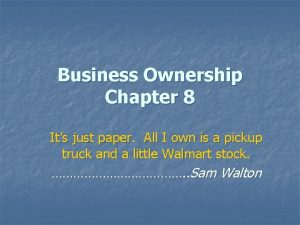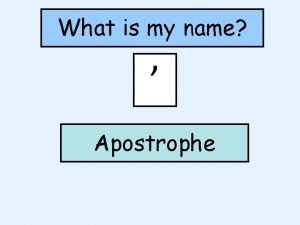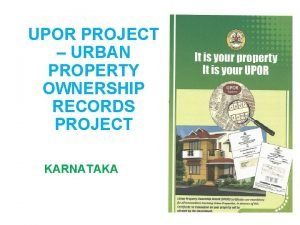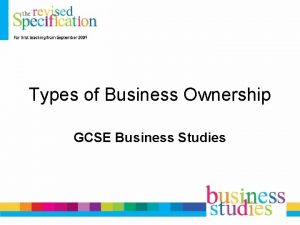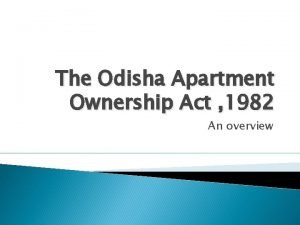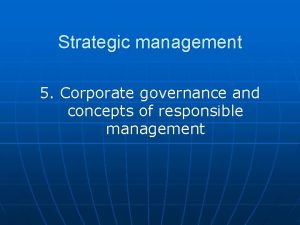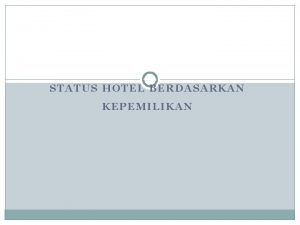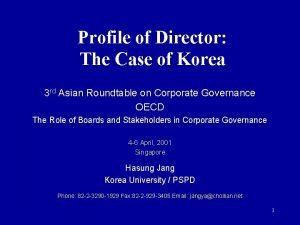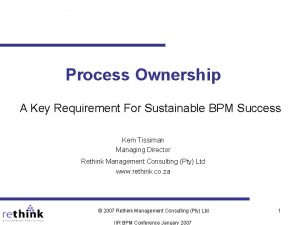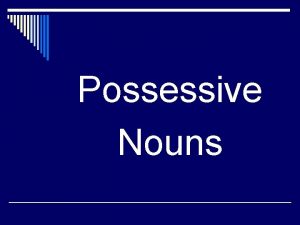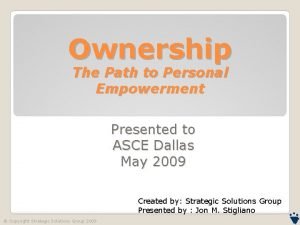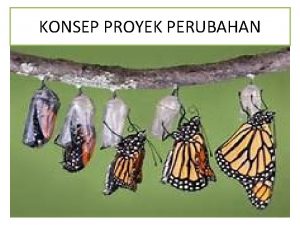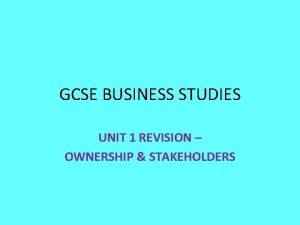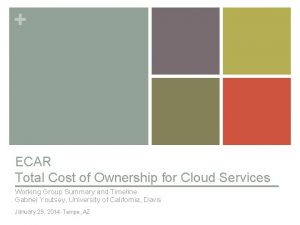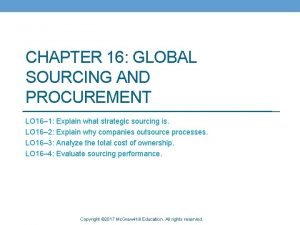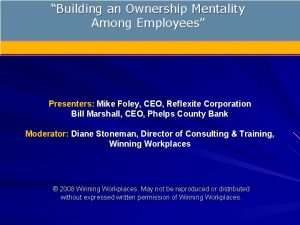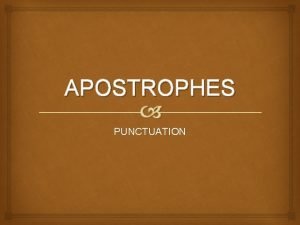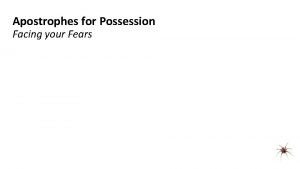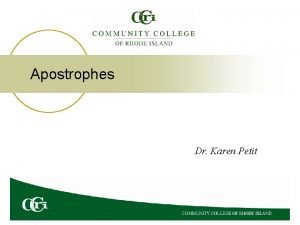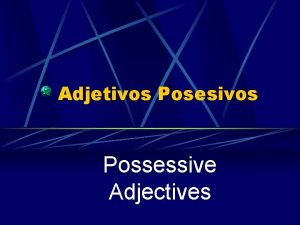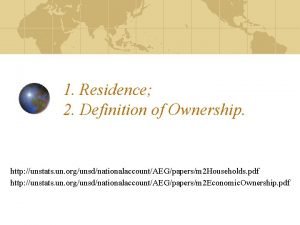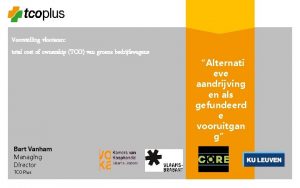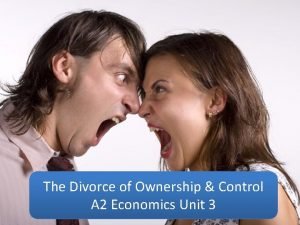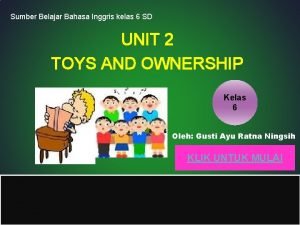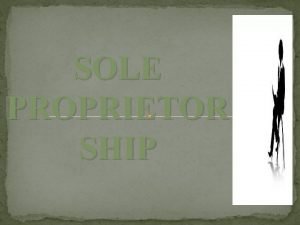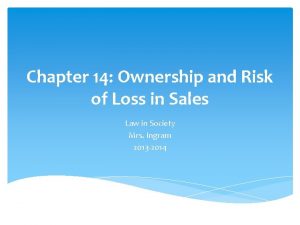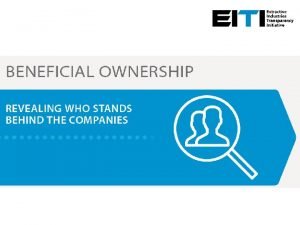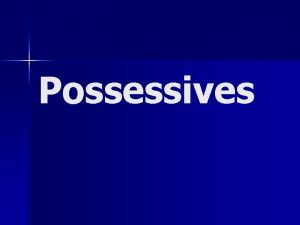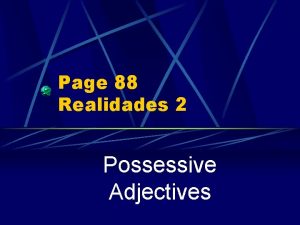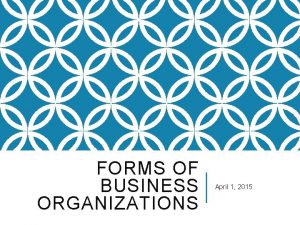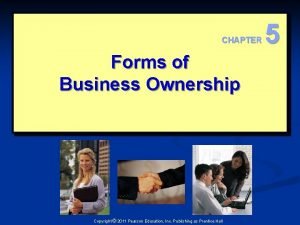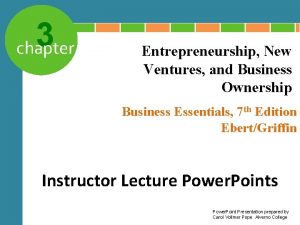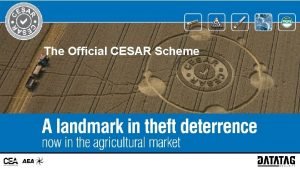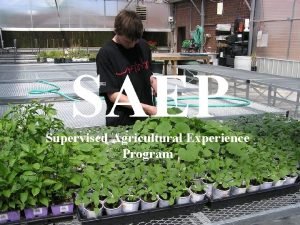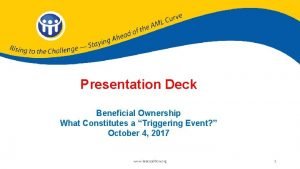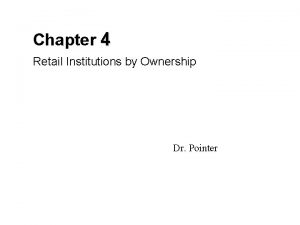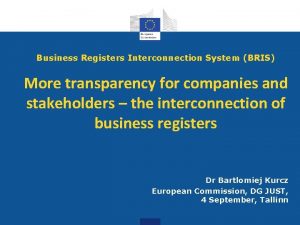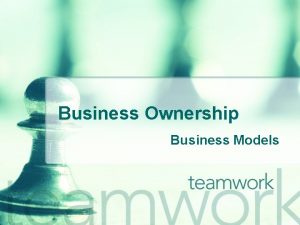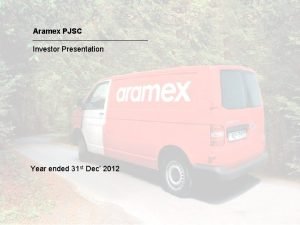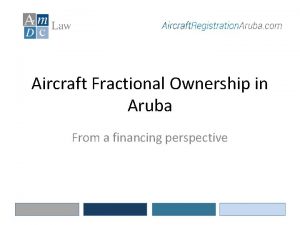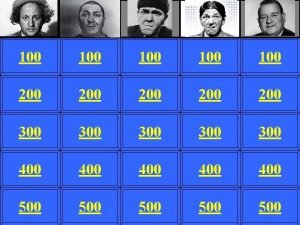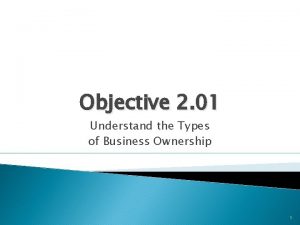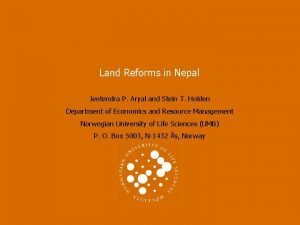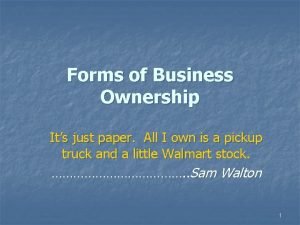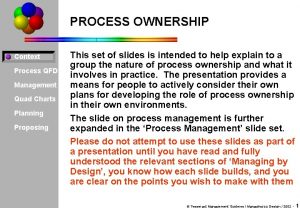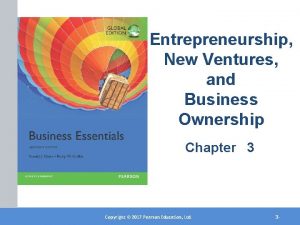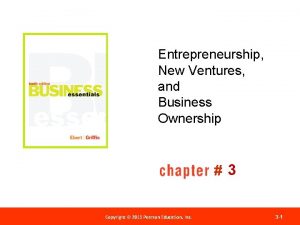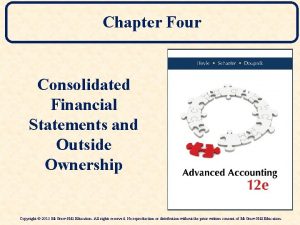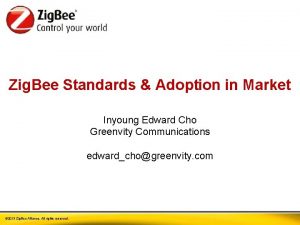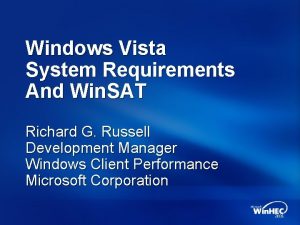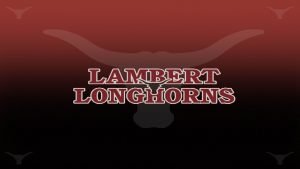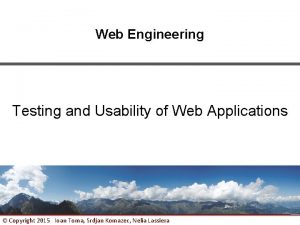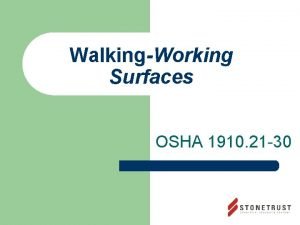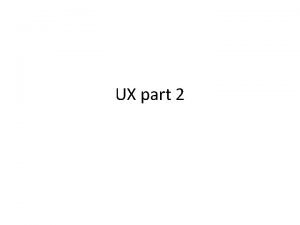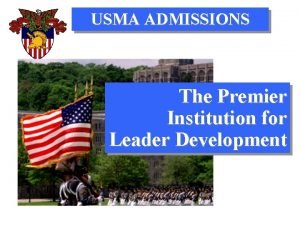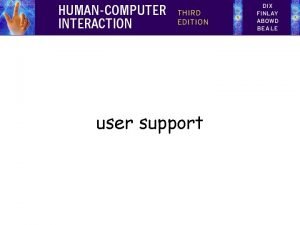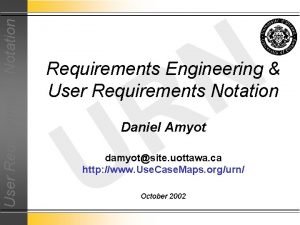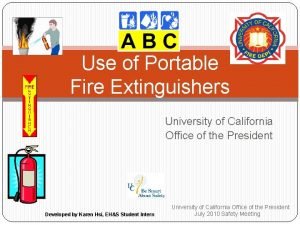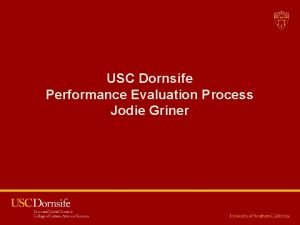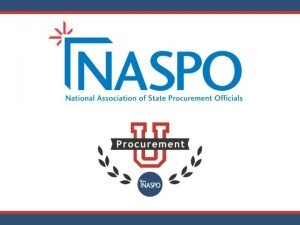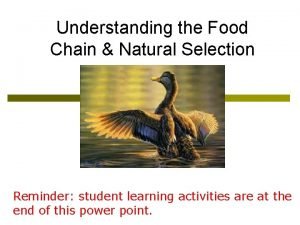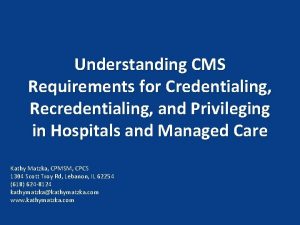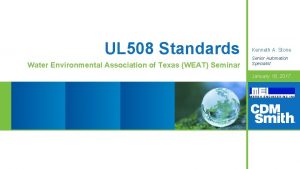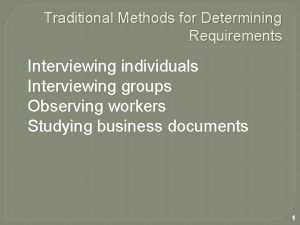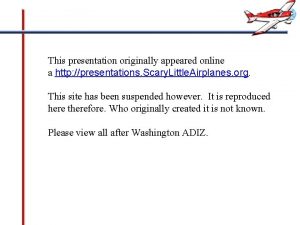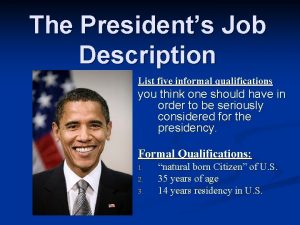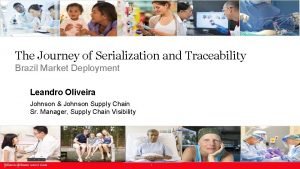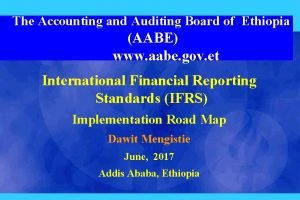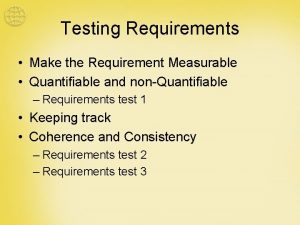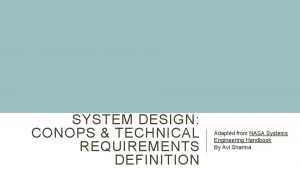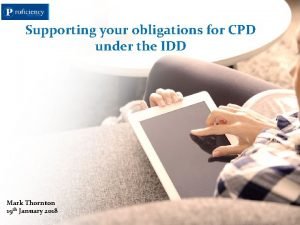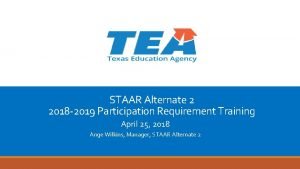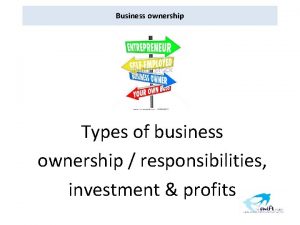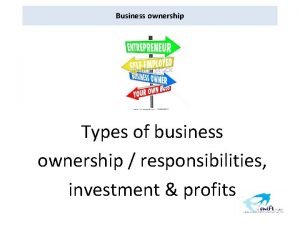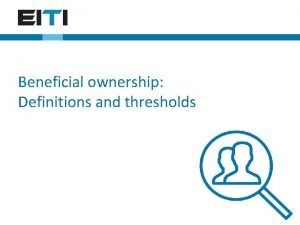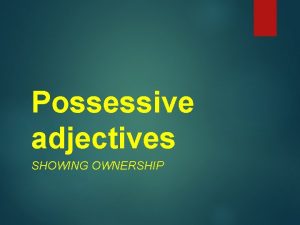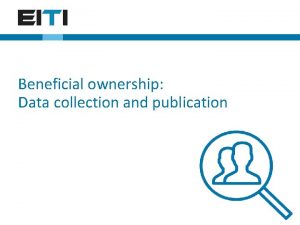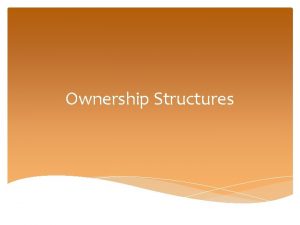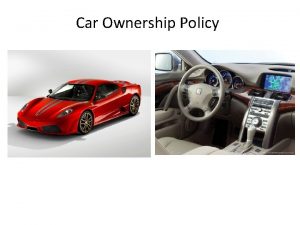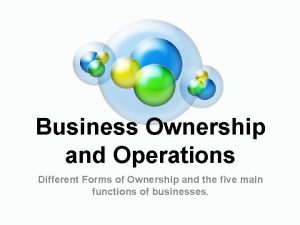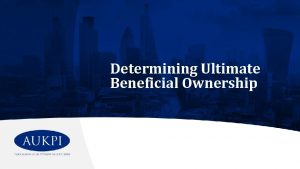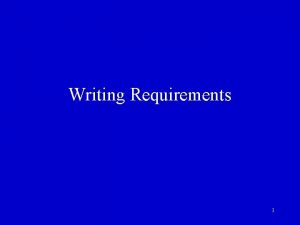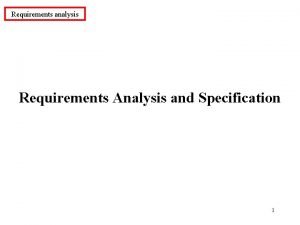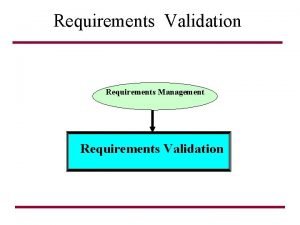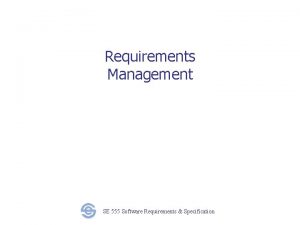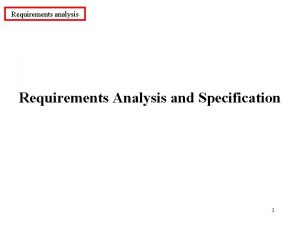Chapter 2 Ownership Requirements 1 Ownership Requirements Ownership













































































































- Slides: 109

Chapter 2 Ownership Requirements 1

Ownership Requirements • Ownership requirements can be divided into two main areas. – Owners must meet one of the Qualifying Forms of Ownership. – These qualifying owners must meet Additional Requirements for Qualifying Owners. 2

“Individually Owned” • All property qualifying for present-use value must be “individually owned. ” • Originally, this meant that only individuals could qualify, but the term has been periodically expanded by the General Assembly to include other forms of ownership, such as business entities and trusts. 3

“Individually Owned” • Because people may incorrectly interpret the requirement that a property be “individually owned” as a requirement that the property be owned by an individual, this presentation will often use the more generic terms “qualifying owners” or “qualifying forms of ownership” as substitutes for the somewhat misleading statutory term “individually owned. ” 4

Qualifying Forms of Ownership • There are four categories of qualifying owners: – Individuals – Certain Business Entities – Certain Trusts and Testamentary Trusts – Certain Tenants in Common 5

Qualifying Forms of Ownership • Individuals – These are properties owned in a person’s actual name. – Property on which a life estate has been retained is considered owned by the owner of the life estate. [See G. S. 105 -302(c)(8). ] Qualification for the present-use value program will be based on the qualifications of the owner of the life estate. 6

Qualifying Forms of Ownership • Individuals (cont’d) – Properties owned by husband wife as tenants by the entirety fall into this category. – The courts have ruled that property owned by husband wife as tenants by the entirety is a different ownership than property owned by either the husband or wife separately. 7

Qualifying Forms of Ownership • Individuals (cont’d) – Property listed in the name of an “unknown owner” or in the name of an occupant under G. S. 105 -302(c)(12) could be individually owned and may qualify if and only if all individual owners can be identified. – An occupant is not necessarily an owner. 8

Qualifying Forms of Ownership • Business Entities are: – limited liability companies, – general partnerships, – limited partnerships, and – corporations. 9

Qualifying Forms of Ownership • Business Entity Requirements 1. A business entity must have agriculture, horticulture, or forestry as its principal business. The principal business requirement applies only to the business entity that owns the land does not apply to the members of the business entity. 10

Qualifying Forms of Ownership • If the business entity has been approved for classification as qualifying for agriculture, horticulture, or forestry in another county, the assessor must presume that the principal business of the business entity is agriculture, horticulture, or forestry. • Assessor may rebut with sufficient evidence. 11

Qualifying Forms of Ownership • Business Entity Requirements (cont’d) 2. All members of the business entity must be individuals, either directly or indirectly. Directly or indirectly—All interest in a business entity is ultimately owned by individuals, if you look far enough down the ownership structure. Essentially, you are “looking through” all of the intermediate ownerships to identify the individual level of ownership. 12

Qualifying Forms of Ownership • Business Entity Requirements (cont’d) 3. All individual members must be either actively engaged in the principal business of the entity or be the relative of an individual member who is actively engaged in the principal business of the entity. Once you have identified all of the individuals who own interest in the business entity, either directly or indirectly, you can now apply the actively engaged requirement to those individuals. -Note: Some exceptions to “actively engaged and “principal business” requirements discussed later. 13

Qualifying Forms of Ownership • Business Entity Requirements (cont’d) Direct Business Entity Trust Individual Corporation Individual Indirect Individual Ltd Partnership LLC Individual Indirect 14

Qualifying Forms of Ownership • Business Entity Requirements (cont’d) 4. A business entity cannot be a corporation whose shares are publicly traded. Neither can any of its members be corporations whose shares are publicly traded. -Note: North Carolina nonprofit corporations, by statute, cannot have members (shareholders); therefore, these corporations cannot be individually owned, and cannot be qualifying owners. Nonprofits formed in another state would typically have the same restrictions, but those applicants should be reviewed on a case-by-case basis. 15

Qualifying Forms of Ownership • Business Entities—Principal Business – Principal business is not defined in the statutes but the term implies that some non-farming activity is permissible. It seems reasonable that at least 50% of the business must be farming related, but the statutes do not explicitly make that statement. 16

Qualifying Forms of Ownership • Business Entities—Actively Engaged – Actively engaged is not defined in the statutes. The Property Tax Commission did express its opinion in Blue Investment Company vs. Scotland County (1988) that actively engaged certainly includes activities such as operating farming equipment, caring for animals, and cultivating crops, but it may also include other less physical activities such as business management of the operation, supervision of labor, and decisions as to crop investment and capital equipment purchases. 17

Qualifying Forms of Ownership • Business Entities—Exception for Family Business Entities – If all members of the business entity are relatives of each other, the business entity may lease the land out to a tenant farmer to farm the land and, by statutory definition, the business entity can meet the principal business and actively engaged requirements. Otherwise, business entities are not allowed to lease the land out to a tenant farmer. 18

Qualifying Forms of Ownership • Business Entities—Exception for Family Business Entities (cont’d) – It should be noted that the principal business of the business entity must still be agriculture, horticulture, or forestry. In this exception, the leasing of land can meet the principal business requirement, but it would not preclude disqualification if the family business entity had an actual disqualifying principal business (such as real estate development) despite the fact that it also leased out some of its land for farming purposes. 19

Qualifying Forms of Ownership • Trusts – Must be created by an individual who transferred the land to the trust. • Therefore, for example, transfers from a business entity to a trust would not qualify, nor would a transfer from one individual to a trust created by another individual. It’s important to remember that a wide variety of trusts can exist, but only certain specific types of trusts can qualify for PUV. 20

Qualifying Forms of Ownership • Trusts (cont’d) – Each beneficiary must be an individual, either directly or indirectly, who is either the creator of the trust or a relative of the creator of the trust. The “directly or indirectly” principal requires “looking through” all of the intermediate ownerships to identify the individual level of beneficial interest. 21

Qualifying Forms of Ownership • Trusts (cont’d) – Once you have identified all of the individuals who are beneficiaries, either directly or indirectly, you can now determine whether they meet the requirement that they must be either the creator of the trust or a relative of the creator. 22

Qualifying Forms of Ownership • Testamentary Trusts – Must be created by an individual who transferred the land to the trust. – Land must have qualified for classification in the hands of the individual prior to transfer to the trust. – At the time of the creator’s death, the creator had no relatives. – Trust income, less reasonable administrative expenses, is used exclusively for educational, scientific, literary, cultural, charitable, or religious purposes. 23

Qualifying Forms of Ownership • Tenancy in Common – Tenants in common is a form of ownership where multiple owners can own undivided interests in real property. – A tenancy in common can qualify for presentuse value only if each tenant would qualify as an owner if the tenant were the sole owner. 24

Qualifying Forms of Ownership • Tenancy in Common (cont’d) – Each tenant must be a qualifying owner. – Each tenant must also meet the additional ownership requirements imposed on qualifying owners (i. e. homeplace, length of ownership, etc. ) that will be discussed later in this presentation. 25

Qualifying Forms of Ownership • Tenancy in Common—Similar But Not Identical Tenants in Common – Each tenancy in common is a separate ownership. Since the listing owner is the tenancy in common, each tenancy in common must list as that specific tenancy in common. Only property owned by the identical tenancy in common can be included in the same farm unit. 26

Qualifying Forms of Ownership • Tenancy in Common—Similar But Not Identical Tenants in Common – Each tenancy in common is a separate ownership and one tenancy in common cannot list the property of the other tenancy in common. – Also, any change in an existing tenancy in common results in a new listing and therefore a new ownership. 27

Qualifying Forms of Ownership • Tenancy in Common—Splitting Interests – Tenants in common may request to have their individual shares treated as owned by them individually [per G. S. 105 -302(c)(9)]. – However, they may only do so if they request that the assessor allow them to list their interests separately and if the assessor grants the request. 28

Qualifying Forms of Ownership • Tenancy in Common—Splitting Interests – The assessor is given complete statutory authority and discretion to choose to deny or allow these requests. However, there are some concerns that may arise if these requests are allowed. – Given these concerns, it is recommended that assessors deny requests by tenants in common to split their undivided interests into separate listings. 29

Requirements for Qualifying Owners • All tracts owned by qualifying owners must meet either the Standard Ownership Requirements. . . OR • . . . meet one of the Two Exceptions to the Standard Ownership Requirements. 30

Requirements for Qualifying Owners • Standard Requirements—Individuals – If owned by an individual, the property must meet one of these requirements: 1. The property is the owner’s place of residence as of January 1. 31

Requirements for Qualifying Owners • Standard Requirements—Individuals 2. The property has been owned by the current owner or a relative of the current owner for the four full years preceding January 1 of the year for which application is made. 32

Requirements for Qualifying Owners • Standard Requirements—Individuals 3. If transferring from a business entity or trust to the current owner (an individual), the property must have been qualified for and receiving PUV at the time of transfer. Additionally, at the time of transfer, the current owner must have been a member of the business entity or a beneficiary of the trust. 33

Requirements for Qualifying Owners • Standard Requirements—Business Entities – If the current owner is a business entity, the property must have been owned by one or more of the following for the four years immediately preceding January 1 of the year for which application is made: • The business entity. • A member of the business entity. • Another business entity whose members include a member of the business entity that currently owns the land. 34

Requirements for Qualifying Owners • Continuation of Eligibility for Business Entity Conversions & Mergers – When the owner is a business entity, and either converts to another business entity form or merges with one or more other entities, and these processes are carried out according to statute, the result is not considered a transfer, so no new application, etc. is required. 35

Requirements for Qualifying Owners • Standard Requirements—Trusts – If the current owner is a trust, the property must have been owned by the trust or by one or more of the creators of the trust for the four full years preceding January 1 of the year for which application is made. 36

Requirements for Qualifying Owners • Standard Requirements—Tenancy in Common – A qualifying tenancy in common can consist of individuals, business entities, and trusts. – However, a tenancy in common can qualify for present-use value only if each tenant would qualify as an owner if the tenant were the sole owner. – Therefore, each tenant must be a qualifying owner and meet the applicable standard ownership requirements in the immediately preceding slides. 37

Requirements for Qualifying Owners • Standard Requirements—Tenancy in Common--Transfers and Eligibility – As discussed earlier, each combination of tenants forms a different tenancy in common and therefore a different ownership. • Remember: – A, B, & C = A, B, & C but – A, B, & C ≠ A & B or A & C or B & C or A or B or C 38

Requirements for Qualifying Owners • Standard Requirements—Tenancy in Common—Transfers and Eligibility – Once a tenancy in common is approved for initial present-use value qualification, any transfer to another tenancy in common can only qualify for continued classification through the Exception for Continued Use (as discussed later in the presentation). 39

Requirements for Qualifying Owners • Standard Requirements—Tenancy in Common—Transfers and Eligibility – Any transfer of one tenant’s full interest to an existing tenant or any transfer of one tenant’s interest (partial or full) to a new tenant creates a new listing ownership for the new tenancy in common. 40

Requirements for Qualifying Owners • Two Exceptions to the Standard Requirements for Qualifying Owners: 1. Exception for Continued Use 2. Exception for Expansion of Existing Unit 41

Requirements for Qualifying Owners • Exception for Continued Use – This exception allows a qualifying owner to bypass the Standard Ownership Requirements if all of the following conditions are met: 42

Requirements for Qualifying Owners • Exception for Continued Use (cont’d) 1. The land was appraised at its present-use value at the time title to the land passed to the new owner, and 2. The new owner will continue to use the land for the purposes it was classified at and appraised for under present-use value classification for the previous ownership, and 43

Requirements for Qualifying Owners • Exception for Continued Use (cont’d) 3. The land will continue to meet all the applicable size requirements. If the new owner does not own any other land in present-use value, the land must be able to meet the size requirements for an initial qualifying tract. If the new owner already has a qualifying tract of the same classification in use value, the transferred land may be less than the minimum initial required acreage if the land can properly be considered an additional tract of the existing farm unit, and 44

Requirements for Qualifying Owners • Exception for Continued Use (cont’d) 4. The new owner must file an application for present-use value within 60 days of the date of transfer. Untimely applications may be filed and approved under certain conditions, and 5. The new owner certifies that they accept liability for any deferred taxes that exist on the property. 45

Requirements for Qualifying Owners • Exception for Continued Use (cont’d) – This exception does apply when the seller has voluntarily paid some, all, or none of the deferred taxes, but has NOT requested removal from the present-use value program. – This exception does not apply when the seller has voluntarily removed the property from the present -use value program, regardless of whether or not any of the rollback taxes have been paid. • Voluntary Removal is irreversible. 46

Requirements for Qualifying Owners • Exception for Continued Use (cont’d) – NCDOR strongly recommends that the counties require the owner (seller) or the owner’s (seller’s) attorney to sign the appropriate form wherein they acknowledge whether they wish to pay some or all of the deferred taxes while remaining in the present-use value program (Form AV-3), whether they are requesting voluntary removal from the present-use value program (Form AV 6), or whether they are only requesting an estimate of the deferred taxes (Form AV-7). This recommendation is for the protection of all parties involved. 47

Requirements for Qualifying Owners • Exception for Expansion of Existing Unit – This exception for expansion of an existing farm unit is designed to allow those property owners who already have qualifying property under the present-use value program to expand their farm and immediately qualify for the next year for present-use value classification on the new land without having to meet the Standard Ownership Requirements. 48

Requirements for Qualifying Owners • Exception for Expansion of Existing Unit (cont’d) – This exception only applies to property that was not appraised at present-use value at the time of transfer. If the property was not in present-use value or the previous owner requested removal from the program, the option for immediate qualification for year of transfer under the Exception for Continued Use will not be an option since the property must be in present-use value at the time of transfer under that exception. 49

Requirements for Qualifying Owners • Exception for Expansion of Existing Unit (cont’d) – Under the provisions for Exception for Expansion of Existing Unit, the new owner may still immediately qualify the land for the next year if all of the following conditions are met: 50

Requirements for Qualifying Owners • Exception for Expansion of Existing Unit (cont’d) 1. At the time of transfer, the new owner owned other land already in present-use value. 2. At the time of transfer, the land was not appraised at its present-use value. 3. At the time of transfer, the land being transferred was being used for the same purpose as the land owned by the new owner that is already in present 51 use value.

Requirements for Qualifying Owners • Exception for Expansion of Existing Unit (cont’d) 4. At the time of transfer, the land being transferred was eligible for present-use value with regard to production and sound management requirements. Since this exception applies to the expansion of an existing farm unit only, the initial size requirements would not need to be applied to the additional tract being transferred. 52

Requirements for Qualifying Owners • Exception for Expansion of Existing Unit (cont’d) 5. The new owner must timely file a new application during the next listing period, typically the month of January. Since land under this exception was not already in present-use value at the time of transfer, an initial application of present-use value classification will be required. The initial application for present-use value should be filed during the regular listing period of the next tax year. 53

Ownership Examples 54

1 -Q • Son applies for PUV. Son has owned the property for two years. Prior to transfer to the son, the father had owned the property for 20 years. 55

1 -A • The ownership requirement has been met since the son is an individual which is a qualifying form of ownership, and the owner has satisfied the standard ownership requirement that either the owner or the owner’s relative must have owned the property for four full years preceding the January 1 of the year for which application is made. 56

2 -Q • An individual applies for PUV and has owned the property for three years but moved onto the property last summer as the owner’s principal place of residence. 57

2 -A • The ownership requirement has been met since an individual is a qualifying form of ownership, and the owner has satisfied the standard ownership requirement by establishing the property as the owner’s principal place of residence as of January 1 of the year for which application is made. 58

3 -Q • An individual applies for PUV and has owned the property for three years but does not live on the property. 59

3 -A • The ownership requirement has not been met. Although an individual is a qualifying form of ownership, the owner has not satisfied the standard ownership requirement by either owning the property for four full years preceding the January 1 of the year for which application is made, or by establishing the property as the owner’s principal place of residence as of January 1 of the year for which application is made. 60

4 -Q • Father owns tract of land in PUV but transfers the property to his son. Father retains a life estate on the tract. Son is the remainderman. 61

4 -A • The owner of the life estate is considered the owner of the real property. Therefore, the father remains the owner of the property and continues to be a qualifying owner. • The assessor might wish to request that the father file an updated application indicating his status as owner of the life estate, however, the statutes do not require it. 62

5 -Q • Business entity applies for PUV. All members are brothers and sisters but only one of the members is actively engaged in the farming operation. 63

5 -A • Since all members are relatives, only one member has to be actively engaged. This ownership would qualify. 64

6 -Q • Business entity applies for PUV. The five members are not relatives, but four members are actively engaged in the farming operation. 65

6 -A • Since the members are not relatives, all members have to be actively engaged. This ownership would not qualify. 66

7 -Q • Business entity applies for PUV on a 40 acre agricultural tract. The business entity also owns four convenience stores and a restaurant. 67

7 -A • It is unlikely that the business entity can prove that its principal business is agriculture, horticulture, or forestry. 68

8 -Q • Business entity applies for PUV on a 40 acre agricultural tract. The business entity owns no other properties. The members of the business entity are not relatives and all of the farming operations are leased out to a tenant farmer. 69

8 -A • Since the members of the business entity are not relatives, the exception for the leasing of land would not apply. The business entity would not qualify since its principal business was the leasing of land rather than agriculture, horticulture, or forestry. 70

9 -Q • Business entity applies for PUV. Four members of the business entity are individuals and one member is an LLC. The LLC has two members who are individuals. 71

9 -A • All members of a business entity must be individuals, directly or indirectly. Here there are four individuals who are directly members and two individuals who are indirectly members. • This business entity can qualify if the principal business and actively engaged requirements are met. The principal business test would be applied to the business entity but not to any members of the business entity. The actively engaged test would be applied to the six individuals. 72

10 -Q • An otherwise qualifying business entity applies for PUV. The business entity has owned the property for the last two years. The property owner for the three years prior to transfer to the business entity was one of the current members of the business entity. 73

10 -A • The ownership requirement has been met since the property has been owned by the business entity or by one or more of its members for the four years preceding the January 1 for which application is made. 74

11 -Q • Tenancy in common applies for PUV. One of the tenants is a trust. 75

11 -A • The tenancy in common may qualify. A tenancy in common can qualify for presentuse value only if each tenant would qualify as an owner if the tenant were the sole owner. Each tenant must be a qualifying owner and each tenant’s undivided interest in the tenancy in common must meet all the applicable ownership requirements. 76

12 -Q • Refer Back to example 8 -Q • Business entity applies for PUV on a 40 -acre agricultural tract. The business entity owns no other properties. The members of the business entity are not relatives and all of the farming operations are leased out to a tenant farmer. – Suppose the 40 -acre agricultural tract is owned by two separate business entities as tenants in common. Each business entity has a single individual member, and the individuals are not relatives. All of the farming operations are leased to a farmer. 77

12 -A • Since each tenant in a tenancy in common is evaluated as if it were the sole owner, and the business entities would each qualify separately, this tenancy in common could meet the ownership requirement. • In contrast, Example 8 -Q is a situation showing that a single business entity, owned by multiple owners who are not relatives, could not qualify. 78

13 -Q • Tenancy in common applies for PUV. One of the tenants is a business entity whose principal business is agriculture and whose members are all actively engaged in the farming operation. 79

13 -A • The tenancy in common may qualify. A tenancy in common can qualify for presentuse value only if each tenant would qualify as an owner if the tenant were the sole owner. Each tenant must be a qualifying owner and each tenant’s undivided interest in the tenancy in common must meet all the applicable ownership requirements. 80

14 -Q • Tenancy in common applies for PUV on two tracts. Upon investigation, tract one is owned by a tenancy in common with tenants A, B, and C. Tract two is owned by a tenancy in common with tenants B, C, and D. 81

14 -A • A separate application will be needed for each ownership, and the tract under each ownership will need to qualify on its own merits. • All tracts in a farm unit must be under the same ownership. Multiple tracts owned as tenants in common must have exactly the same tenants in each tenancy in common. Otherwise the ownership is not the same. 82

15 -Q Examples of transfers of interests in/out/between tenants in common. All properties are in PUV at the time of transfer. • Smith transfers 50% to Jones, thus creating a tenancy in common. • Smith and Jones own property as tenants in common. Jones transfers his interest to Smith, thus ending the tenancy in common. • Smith and Jones own property as tenants in common. Jones transfers his interest to his son, thus creating a new tenancy in common and therefore a new listing owner. • Smith and Jones own property as tenants in common. Jones transfers his interest to Williams, thus creating a new tenancy in common and therefore a new listing owner. 83

15 -Q (cont’d) - Smith and Jones own property as tenants in common. Jones transfers his interest to a qualifying LLC of which he is a member, thus creating a new tenancy in common and therefore a new listing owner. - Smith and Jones own property as tenants in common. Jones transfers his interest to a qualifying LLC of which he is not a member, thus creating a new tenancy in common and therefore a new listing owner. - Smith and an LLC own property as tenants in common. The LLC transfers its interest to a member of the LLC, thus creating a new tenancy in common and therefore a new listing owner. 84

15 -A • All of these situations create a new ownership that will need to file a new application. • In these examples, if the new ownership wishes for the property to remain in PUV, it must do so under the Exception for Continued Use. A new application will need to be filed within 60 days of the date of transfer and the new owner must accept any existing deferred liability. It is recommended that all tenants of the tenancy in common sign the new application and certify that they accept the deferred liability. Even though only one tenant’s interest may have changed ownership, that change created a new tenancy in common and therefore a new listing owner. As such, the new tenancy in common is the owner that is seeking continued qualification by assuming the deferred liability, not just the one tenant’s interest 85 that has been transferred.

16 -Q • Husband owns tract already in PUV. Husband wife apply for PUV on tract owned by them as tenants by the entirety. 86

16 -A • The ownership of the tract owned by the tenancy by the entirety will have to be evaluated separately and cannot be considered as part of the husband’s farm unit. • All tracts in a farm unit must be under the same ownership. Ownership by husband wife as tenants by the entirety is a different ownership than property owned by them either separately or as tenants in common. 87

17 -Q • Seller transfers 5 acres of agricultural land to a buyer who is not a relative. All land is in production and the property is in PUV at the time of transfer. Buyer already owns several other qualifying agricultural tracts in the county that are already receiving PUV. 88

17 -A • The tract does not have to meet the agricultural minimum size requirements since the owner already has at least one tract in an existing agricultural farm unit that meets the size requirement. • Under the Exception for Continued Use, the buyer must file an application within 60 days of the date of transfer and must also assume any existing deferred liability. 89

18 -Q • Buyer owns several tracts already in horticultural PUV. Buyer purchases a 6 acre tract of horticultural land that is not in PUV. The 6 acres have been in active horticultural production under sound management for at least the three previous years. 90

18 -A • Since the property is not in PUV, the buyer cannot qualify for the year of the transfer by using the Exception for Continued Use. • However, the buyer may apply for PUV on the new tract during the next year’s listing period under the Exception for Expansion of Existing Unit. 91

19 -Q • Buyer owns several tracts already in horticulture PUV. Buyer purchases a 6 -acre tract of horticultural land that was receiving PUV. However, the seller voluntarily removed the property from PUV prior to transfer. The 6 acres have been in active horticultural production under sound management for at least the three previous years. 92

19 -A • Since the property is not in PUV, the buyer cannot qualify for the year of the transfer by using the Exception for Continued Use. • However, the buyer may apply for PUV on the new tract during the next year’s listing period under the Exception for Expansion of Existing Unit. 93

20 -Q • Smith and Jones own property as tenants in common. Jones transfers his interest to Williams. 94

20 -A • This transfer creates a new tenancy in common and therefore a new listing owner. • It is a new ownership that will need to file a new application within 60 days of the date of transfer. 95

21 -Q • Buyer, an individual, acquires a working 15 acre farm tract from the Trustee at a mortgage foreclosure sale. The property was in PUV in the hands of the prior owner (the debtor in the mortgage foreclosure). 96

21 -A • Even though the Trustee in a mortgage situation holds legal title to the property, the party which transfers title to the Trustee (usually the debtor on the mortgage loan) is considered to be the owner for property tax purposes [G. S. 105 -302(c)(1)]. Therefore, the buyer could qualify using the Exception for Continued Use. 97

22 -Q • Buyer, an individual, acquires a working 15 acre farm tract from a bankruptcy Trustee. The property was in PUV in the hands of the prior owner (the party in bankruptcy). 98

22 -A • Through the operation of federal bankruptcy laws, a bankruptcy Trustee receives the authority to convey the property of the bankrupt party; however, the bankruptcy Trustee does not normally receive title to the property (i. e. , by deed). The bankrupt party is still the owner of record. Therefore, the buyer could qualify using the Exception for Continued Use. 99

23 -Q • Buyer, an individual, acquires a working 15 acre farm tract from a lending institution, which purchased (“took back”) the property from the Trustee at a mortgage foreclosure sale. The property was in PUV in the hands of the debtor in the mortgage foreclosure. 100

23 -A • A bank or other lending institution likely cannot qualify as an owner in PUV, for both “principal business” and “actively engaged” reasons. Therefore, the property could not have properly been in PUV at the time of transfer to the buyer, and the buyer could not qualify using the Exception for Continued Use. 101

24 -Q • At 1: 35 p. m. , a closing attorney records the deed to a lending institution that purchased (“took back”) property from the Trustee at a mortgage foreclosure sale. At 1: 36 p. m. , the attorney records the deed from the lending institution to Buyer, an individual. The property was in PUV in the hands of the debtor in the mortgage foreclosure. 102

24 -A • The duration of the intervening unqualified ownership is irrelevant. For the same reasons given above, Buyer could not qualify using the Exception for Continued Use. 103

25 -Q • In June, 2013, Owner purchases a 20 -acre tract of wooded land adjoining her 1 -acre homesite, which includes her residence. The land was not in PUV at the time of transfer, the seller was not a relative, and she has no other land in PUV. In January of 2014, she applies forestry PUV, including an appropriate forest management plan. 104

25 -A • Because the additional 20 acres have effectively become part of the same tract of land as Owner’s place of residence, the additional land meets the standard ownership requirements. 105

26 -Q • In June, 2013, Owner purchases a 20 -acre tract of wooded land adjoining his 18 -acre tract of wooded land, which he has owned and managed for commercial timber production for 45 years. The land purchased was not in PUV at the time of transfer, the seller was not a relative, and Owner has no other land in PUV. In January of 2014, he applies forestry PUV on the entire 38 acres, including an appropriate forest management plan. 106

26 -A • Because the 18 -acre tract is not large enough to qualify for PUV (see next chapter), and because he has not owned the 20 -acre tract for a full four years, none of the 38 acres can qualify for PUV until January of 2018. 107

27 -Q • A business entity receiving agriculture present-use value in County A makes an application for agriculture present-use value in County B. The Assessor in County B requires proof from the applicant that the principal business of the business entity is Agriculture. 108

27 -A • The assessor must accept the application in County B without additional information from the taxpayer since the principal business of the business entity was determined to be agriculture in County A, unless the assessor in County B has evidence that the principal business of the entity is not agriculture. 109
 Chapter 5 business organization
Chapter 5 business organization Chapter 7 types of business ownership
Chapter 7 types of business ownership Chapter 4 choosing a form of business ownership
Chapter 4 choosing a form of business ownership A corporation organized to provide a social educational
A corporation organized to provide a social educational Chapter 6 business ownership and operations
Chapter 6 business ownership and operations Main types of business
Main types of business A business that moves goods from one business to another
A business that moves goods from one business to another Horizontal merger
Horizontal merger Chapter 4 requirements engineering
Chapter 4 requirements engineering Apostrophe for ownership
Apostrophe for ownership Break bulk warehouse
Break bulk warehouse Gramathana maps
Gramathana maps Public limited company gcse business
Public limited company gcse business Three basic forms of business ownership
Three basic forms of business ownership Odisha apartment ownership act 1982
Odisha apartment ownership act 1982 What is ownership
What is ownership Status kepemilikan hotel
Status kepemilikan hotel Circular ownership
Circular ownership Process ownership
Process ownership Apostrophe to show ownership
Apostrophe to show ownership Nouns that show ownership
Nouns that show ownership What is ownership
What is ownership Mi mis tu tus
Mi mis tu tus Proyek perubahan adalah
Proyek perubahan adalah Stakeholder gcse business
Stakeholder gcse business A sole trader example
A sole trader example Total cost of ownership in cloud computing
Total cost of ownership in cloud computing Deed of declaration in sinhala
Deed of declaration in sinhala Ownership based retailing
Ownership based retailing Total cost of ownership supply chain
Total cost of ownership supply chain Form of ownership example
Form of ownership example Principle agent problem
Principle agent problem Ownership mentality
Ownership mentality Functions of apostrophes
Functions of apostrophes Use an apostrophe to show possession the song of the bird
Use an apostrophe to show possession the song of the bird S to show ownership
S to show ownership The possessive adjectives show ownership.
The possessive adjectives show ownership. What is ownership
What is ownership Total cost of ownership voorbeeld
Total cost of ownership voorbeeld Divorce of ownership from control is a characteristics of
Divorce of ownership from control is a characteristics of Materi bahasa inggris kelas 4 toys and games
Materi bahasa inggris kelas 4 toys and games Introduction of sole trader
Introduction of sole trader Frontline ownership
Frontline ownership Moat house surgery
Moat house surgery Loss of ownership
Loss of ownership Ownership
Ownership Topelcom
Topelcom Capitulo 2a possessive adjectives p.88
Capitulo 2a possessive adjectives p.88 Business ownership and registration vocabulary
Business ownership and registration vocabulary Basic forms of ownership
Basic forms of ownership Entrepreneurship new ventures and business ownership
Entrepreneurship new ventures and business ownership 7 types of business ownership
7 types of business ownership Cesar scheme
Cesar scheme Ownership/entrepreneurship sae examples
Ownership/entrepreneurship sae examples Beneficial ownership triggering events
Beneficial ownership triggering events 6 types of business ownership
6 types of business ownership Wholesaler-retailer franchise
Wholesaler-retailer franchise Beneficial ownership registers interconnection system
Beneficial ownership registers interconnection system Business ownership models
Business ownership models Aramex ownership structure
Aramex ownership structure Fractional ownership financing
Fractional ownership financing 200200200
200200200 Types of business ownership
Types of business ownership Land ownership rights
Land ownership rights Forms of business ownership assignment
Forms of business ownership assignment How to make a qfd chart in excel
How to make a qfd chart in excel Ooredoo slogan
Ooredoo slogan A government-created monopoly arises when
A government-created monopoly arises when Entrepreneurship new ventures and business ownership
Entrepreneurship new ventures and business ownership Entrepreneurship new ventures and business ownership
Entrepreneurship new ventures and business ownership Consolidated financial statements and outside ownership
Consolidated financial statements and outside ownership Global zig-bee automation market
Global zig-bee automation market Windows vista system requirements
Windows vista system requirements Windermere high school guidance counselors
Windermere high school guidance counselors Whittling chip requirements
Whittling chip requirements Osha hot work standard
Osha hot work standard Ggc dual enrollment
Ggc dual enrollment Lambert graduation requirements
Lambert graduation requirements Web application usability
Web application usability Osha fall protection standard 1910
Osha fall protection standard 1910 Ux requirements gathering
Ux requirements gathering Usma admissions
Usma admissions What are the 4 main types of assistance that users require?
What are the 4 main types of assistance that users require? User requirements notation
User requirements notation Cal osha fire extinguisher
Cal osha fire extinguisher Usc requirements
Usc requirements Uppcc recertification
Uppcc recertification University canada west english requirements
University canada west english requirements Ung oconee majors
Ung oconee majors Ib diploma
Ib diploma Requirements for natural selection
Requirements for natural selection Cms credentialing requirements
Cms credentialing requirements Ul 508b
Ul 508b Camping merit badge requirements
Camping merit badge requirements Traditional methods for determining requirements
Traditional methods for determining requirements Airspace entry requirements
Airspace entry requirements Wedding planning requirements
Wedding planning requirements What are the informal qualifications to be president?
What are the informal qualifications to be president? Sas core service
Sas core service Sncm serialization
Sncm serialization Importance of requirements
Importance of requirements Seal of biliteracy florida
Seal of biliteracy florida Accounting and audit board of ethiopia
Accounting and audit board of ethiopia Quantifiable requirements
Quantifiable requirements Technical requirements definition
Technical requirements definition Idd cpd requirements
Idd cpd requirements 29 cfr 1926 subpart m
29 cfr 1926 subpart m Structuring system process requirements
Structuring system process requirements Characteristics of decorative design
Characteristics of decorative design Staar alt 2 justification examples
Staar alt 2 justification examples
